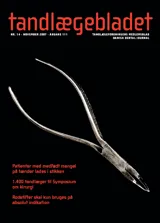Intraorale digitale receptorers dynamikområde og evne til at fremstille et lavkontrastobjekt
Rapporten vurderer nogle fysiske egenskaber ved nye digitale intraorale receptorer i sammenligning med film. Receptorerne bestod af tre fosforplader, tre CCD-sensorer, to CMOS-sensorer og to film. Billedgengivelsen af et lavkontrastaluminiumsfantom med huller af varierende dybde og diameter blev vurderet ved forskellige rørspændinger og eksponeringstider. Artiklen giver et bud på en kvalitetstest af digitale receptorer med henblik på deres evne til at gengive små kontrastforskelle (hvilket kan sammenlignes med cariesdiagnostik). Kontrollen kan anvendes til alle typer intraorale digitale receptorer og er let at udføre.
Dynamic range and perceptibility of contrast in intra-oral digital receptors. This paper describes an experiment to assess the comparative quality of images created using a variety of intra-oral digital receptors. Eight intra-oral digital receptors were used, with two films for reference (Table 1). In relation to the digital receptors, for the Digora storage phosphor system (PSP), two types of plates were included (SR-1 and a new version, DT-1). For Dixi-2 CCD-sensor images, a version was included which did not contain the automatic filter in the software. An Aluminium plate (30 x 40 mm) with 10 x 10 rows of cy -lindrical holes, (diameter range from 0.1 to 1.0 mm, depth from 0.04 to 0.7 mm), was used as the low-contrast object. Exposures were performed at 12 settings (3 kV x 4 exp. sec, Table 2). Four observers assessed the images, in a different order, on a 19” monitor, by recording the smallest hole that was perceptible in each row. Two sessions were performed, one with and one without image manipulation. A two-way- analysis of variance between receptors and observers was conducted. Post hoc t-tests between the number of observed holes with each receptor were conducted. The average number of holes perceived in images from the 11 modalities, when all exposure settings were included, is shown in Table 3. For non-manipulated images significant differences existed between groups A-E (Table 3). No significant difference existed between the two films. For most digital systems, little benefit was gained from image manipulation. Table 4 shows the dynamic range for each receptor, defined as how many of the 12 settings provided an assessable image. Film and PSP plates possessed the largest dynamic range (the optimal setting for film was 65 kV and 0.5 sec, and for PSPs was 70 kV and 0.5 sec.). CCD and CMOS sensors varied in dynamic range, Dixi-2 provided an image at all exposure settings but one, while Sidexis CCD was able to display nine images, CDR-APS six images, CDR wireless eight images, and Dr. Suni Plus only four images (Table 4). At their optimal setting (Fig. 2), there were only small differences in the receptors’ performances except for Dr. Suni Plus, which still had a significantly lower performance than the others. There was a difference between the number of holes perceived by each observer, but the difference was consistent among the receptors (Fig. 3), so that the rank order of results was consistent across all the observers.


